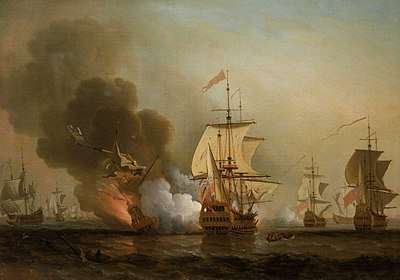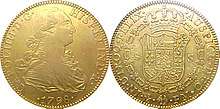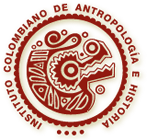Spanish galleon San José
San José was a 64-gun, 3-masted galleon of the Spanish Navy. It was launched in 1698,[1] and sank in battle off the coast of Cartagena, Colombia, in 1708 while laden with gold, silver and emeralds worth about US$17 billion as of 2018.[2] The sunken ship was located by the Woods Hole Oceanographic Institution (WHOI) in November 2015.
 Explosion of San José during Wager's Action. Oil on canvas by Samuel Scott | |
| History | |
|---|---|
| Name: | San José |
| Builder: | Spanish Navy[1] |
| Laid down: | 1697 |
| Launched: | 1698[1] |
| Fate: | Destroyed during the Battle of Barú (Wager's Action), 8 June 1708. |
| General characteristics | |
| Type: | Galleon |
| Tons burthen: | 1,200 tons[1] |
| Propulsion: | Sails |
| Armament: |
|
In July 2017 it was announced that a salvage operation would go ahead.[3]
Career
San José was designed by Francisco Antonio Garrote and built by Pedro de Aróstegui at the shipyard at Mapil, Usurbil, Spain. Construction started in 1697 and ended in 1698. They built twin ships simultaneously and named them San José and San Joaquín.[1]
San José and San Joaquín were part of the Spanish treasure fleet during the War of the Spanish Succession, under General José Fernández de Santillán, the Count of Casa Alegre. On its final voyage, San José sailed as the flagship of a treasure fleet composed of three Spanish warships and 14 merchant vessels sailing from Portobelo, Panama, to Cartagena, Colombia. On 8 June 1708, the fleet encountered a British squadron near Barú, leading to a battle known as Wager's Action. During the battle, the powder magazines of San José detonated, destroying the ship with most of her crew and the gold, silver, emeralds and jewellery collected in the South American colonies to finance the Spanish king's war effort.[1][2] Of the 600 people aboard, only eleven survived.[1]
Search and discovery

San José, is estimated to be worth about $1 billion (£662m) as of 2012,[2][4] based on the speculation that it had up to 11 million 4-doubloons (11 million 8 escudos gold coins; 11 million coins of 27g of 92% gold totaling 8.8 million troy ounces AGW or $11.5 billion) and many silver coins on board at the time of its sinking,[4] similar to its surviving sister ship, San Joaquín. The silver and gold are from the mines of Potosí, Bolivia.[5] San José is called the "Holy Grail of Shipwrecks".[4]
A group of investors from the United States called Glocca Mora Co. operating under the name 'Sea Search Armada' (SSA) claim to have found the ship off the coast of Colombia in 1981, but Colombia refused to sign a 65%/35% share offer and refused SSA permission to conduct full salvage operations at the shipwreck site.[4][6] The Colombian parliament then passed a law giving the state the right to all of the treasure, leaving SSA with a 5% finder's fee, which was to be taxed at 45%. SSA sued Colombia in its own courts in 1989.[4] In July 2007 the Supreme Court of Colombia concluded that any treasure recovered would be split equally between the Colombian government and the explorers. Sea Search Armada subsequently sued in United States courts, but the case was dismissed twice, in 2011 and 2015 on technical grounds, and the galleon declared the property of the Colombian state.[4][5][7] The Colombian government declined to verify that the galleon was at the coordinates stated in the case.[4]
On 27 November 2015, the galleon San José was found by the Colombian Navy though the discovery was not announced by the President of Colombia, Juan Manuel Santos, until 5 December.[7][8][9][10][11] The discovery was made using a REMUS 6000 autonomous underwater vehicle.[12] From the dive photographs, Colombian marine archaeologists[13] have identified San José by her bronze guns engraved with dolphins. Colombia has claimed the galleon as part of its submerged patrimony, thus it is constitutionally obliged to protect and preserve the ship and all its sunken contents. The Government of Colombia has classified the information regarding the location of the galleon as a state secret.[14]
Conservation

The Colombian Institute of Anthropology and History, a government agency ascribed to the Ministry of Culture, is in charge of overseeing all archeological sites in Colombia.[15] The director of the ICANH, Ernesto Montenegro, has stated that soil, and sea depth studies are being carried out in order to examine the methods of extraction of the ship's contents.[16] Then Colombian President, Juan Manuel Santos, has also stated that a museum will be constructed in Cartagena to host some of the contents of the galleon.[17]
On 16 December 2015, the Office of the Inspector General of Colombia requested that the State, and the rest of the parties involved, be responsible for keeping thorough archives regarding the exploration and intervention of the galleon, requesting that the archives be turned in to the Ministry of Culture which is the governmental entity responsible of the underwater cultural heritage. The Inspector General also requested that a representative sum of the coins, ingots, and gemstones, which are not considered to be cultural patrimony under the concept of repetition, must be given to the central bank, Banco de la República, for preservation.[18]
The Minister of Culture, Mariana Garcés Córdoba, stated that 2016 will be "a year of exploration, not extraction".[19] According to the Minister, Colombia sees the discovery as a project of investigation that implies the creation of laboratories that will include the entailment of specialists from different work areas, in order to properly study the shipwreck and its contents.[20]
References
- Gómez, Santiago. "El Galeón San José y la batalla de Barú". Todo A Babor. Retrieved 2015-12-08.
- "Spain says it has rights to Colombian treasure ship". BBC News. December 8, 2015. Retrieved 2015-12-08.
- "Colombia to salvage Spanish galleon San José wreckage". BBC News. BBC News. 6 July 2017. Retrieved 6 July 2017.
- Spilman, Rick (February 29, 2012). "Galleon San Jose, the 'Holy Grail of Ship Wrecks'". The Old Salt Blog. Retrieved 2015-12-08.
- Martinez, Michael; Prifti, Alba (5 December 2015). "Colombia says it found Spanish galleon; U.S. firm claims half of treasure". CNN News. Retrieved 2015-12-08.
- Drye, William (18 December 2015). "Battle Begins Over World's Richest Shipwreck". National Geographic. Retrieved 21 January 2016.
- "Spanish galleon with rumoured £1bn treasure hoard found, says Colombia's president". The Guardian. Reuters. 5 December 2015. Retrieved 5 December 2015.
- Henderson, Emma (5 December 2015). "San Jose galleon shipwreck with £1 billion treasure found off Colombia, says President Juan Manuel Santos". The Independent. Retrieved 2015-12-05.
- "Colombia treasure-laden San Jose galleon 'is found'". BBC News. 5 December 2015. Retrieved 2015-12-05.
- Jenkins, Lin (6 December 2015). "Spanish galleon may contain biggest treasure haul ever found on seabed". The Guardian. Retrieved 21 January 2016.
- Drye, William (9 December 2015). "Treasure on Sunken Spanish Galleon Could Be Biggest Ever". National Geographic. Retrieved 21 January 2016.
- "Hallazgo del Galeón San José - 5 de diciembre de 2015". Presidency of Colombia. Retrieved 6 December 2015.
- "found off the coast of Cartagena de Indias San Jose, a Spanish galleon sunk in 1708". The Spanish. 5 December 2015. Archived from the original on 14 March 2016.
- ""Holy grail" of shipwrecks found off Colombia". CBS News. The Associated Press. 6 December 2015. Retrieved 2015-12-09.
- "El Instituto Colombiano de Antropología e Historia tiene las siguientes funciones y objetivos". ICANH. Retrieved 31 December 2015.
- "Cartagena tendrá museo para preservar piezas del galeón San José: Santos". El País (in Spanish). 5 December 2015. Retrieved 21 January 2016.
- "Construirán museo para exhibir restos de Galeón San José". Portafolio.co (in Spanish). Reuters. 5 December 2015. Retrieved 21 January 2016.
- "Procuraduría General de la Nación reitera aspectos que debe tener en cuenta el Estado colombiano para la administración de riquezas como las del Galeón San José". Office of the Inspector General of Colombia. Retrieved 31 December 2015.
- "La ruta que navegará Colombia con el galeón San José en 2016". vanguardia.com. Retrieved 21 January 2016.
- "Colombia investigará este 2016 hallazgos del galeón San José..." Reporte24.co. Retrieved 21 January 2016.
Bibliography
- Phillips, Carla Rahn (2007). The treasure of the San José: death at sea in the War of the Spanish Succession. Baltimore: Johns Hopkins University Press.